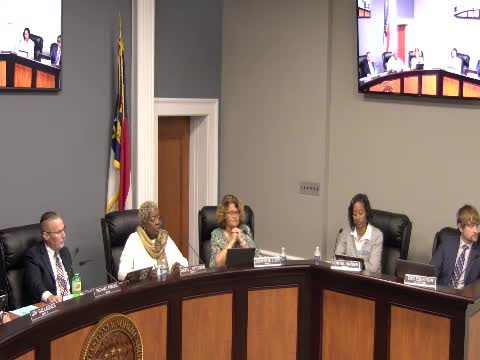Council Adopts Traffic‑Calming Policy Built with Federal Safe Streets Grant; Petition process, scoring rubric to guide projects
November 06, 2025 | Gastonia, Gaston County, North Carolina
This article was created by AI summarizing key points discussed. AI makes mistakes, so for full details and context, please refer to the video of the full meeting. Please report any errors so we can fix them. Report an error »

Gastonia City Council voted unanimously Nov. 6 to adopt a citywide traffic‑calming policy developed with HDR Engineering under the federal Safe Streets and Roads for All program. The policy sets procedures, a toolkit of countermeasures, and an annual application window tied to the fiscal year.
City staff and HDR consultant Jeff Dayton reviewed the policy, which divides requests into two tracks: existing neighborhoods (resident petitions) and new developments (requirements coordinated through the development/TIA process). For existing streets a petition must include signatures from 75% of the property owners within the study area; staff will use a scoring rubric to prioritize projects based on need (for example, lack of sidewalks, recorded speeds, pedestrian exposure, and emergency‑service access). The policy’s toolkit lists vertical deflection devices, curb extensions, median islands, enhanced crosswalks, traffic calming landscaping, and other geometric and non‑geometric measures; the policy also recommends multiuse approaches such as speed cushions in place of full speed humps to limit emergency‑service impacts.
Funding under the policy is separated into three categories: category 1 (100% city‑funded), a shared city/petitioner option, and category 3 (100% petitioner funded). Council members noted the city currently budgets roughly $30,000 annually for speed‑hump projects; staff said that amount will be a starting point if council chooses to allocate funds to the new traffic‑calming program, but staff also asked the council to consider larger allocations in future budgets to implement the full toolkit.
Council members raised operational questions: how the city will help residents secure petitions (staff offered to help hold neighborhood meetings and use city billing/IT resources to notify affected residents), how projects will be prioritized, and the role of emergency services. Staff said petitions and scoring will guide prioritization and that professional engineering judgment will govern final recommendations; staff also said speed cushions, if sized correctly, can reduce emergency‑service impacts compared with traditional speed humps.
The council’s adoption means residents can now submit applications; staff proposed a July 1 submittal deadline aligned with the fiscal year so the city can evaluate requests against available funding and schedule implementation. Staff will publish application materials online and said volunteers and donations can be part of the funding strategy where petitioners opt to supplement city funds.
Why it matters: the policy provides a consistent, documented pathway for neighborhoods to seek traffic calming and gives staff an objective rubric to prioritize projects while balancing safety, emergency response, and limited funding.
What’s next: staff will publish the application and scoring material, work on outreach tools (web forms, neighborhood meetings) and present budget options in the next budget cycle.
City staff and HDR consultant Jeff Dayton reviewed the policy, which divides requests into two tracks: existing neighborhoods (resident petitions) and new developments (requirements coordinated through the development/TIA process). For existing streets a petition must include signatures from 75% of the property owners within the study area; staff will use a scoring rubric to prioritize projects based on need (for example, lack of sidewalks, recorded speeds, pedestrian exposure, and emergency‑service access). The policy’s toolkit lists vertical deflection devices, curb extensions, median islands, enhanced crosswalks, traffic calming landscaping, and other geometric and non‑geometric measures; the policy also recommends multiuse approaches such as speed cushions in place of full speed humps to limit emergency‑service impacts.
Funding under the policy is separated into three categories: category 1 (100% city‑funded), a shared city/petitioner option, and category 3 (100% petitioner funded). Council members noted the city currently budgets roughly $30,000 annually for speed‑hump projects; staff said that amount will be a starting point if council chooses to allocate funds to the new traffic‑calming program, but staff also asked the council to consider larger allocations in future budgets to implement the full toolkit.
Council members raised operational questions: how the city will help residents secure petitions (staff offered to help hold neighborhood meetings and use city billing/IT resources to notify affected residents), how projects will be prioritized, and the role of emergency services. Staff said petitions and scoring will guide prioritization and that professional engineering judgment will govern final recommendations; staff also said speed cushions, if sized correctly, can reduce emergency‑service impacts compared with traditional speed humps.
The council’s adoption means residents can now submit applications; staff proposed a July 1 submittal deadline aligned with the fiscal year so the city can evaluate requests against available funding and schedule implementation. Staff will publish application materials online and said volunteers and donations can be part of the funding strategy where petitioners opt to supplement city funds.
Why it matters: the policy provides a consistent, documented pathway for neighborhoods to seek traffic calming and gives staff an objective rubric to prioritize projects while balancing safety, emergency response, and limited funding.
What’s next: staff will publish the application and scoring material, work on outreach tools (web forms, neighborhood meetings) and present budget options in the next budget cycle.
View full meeting
This article is based on a recent meeting—watch the full video and explore the complete transcript for deeper insights into the discussion.
View full meeting
